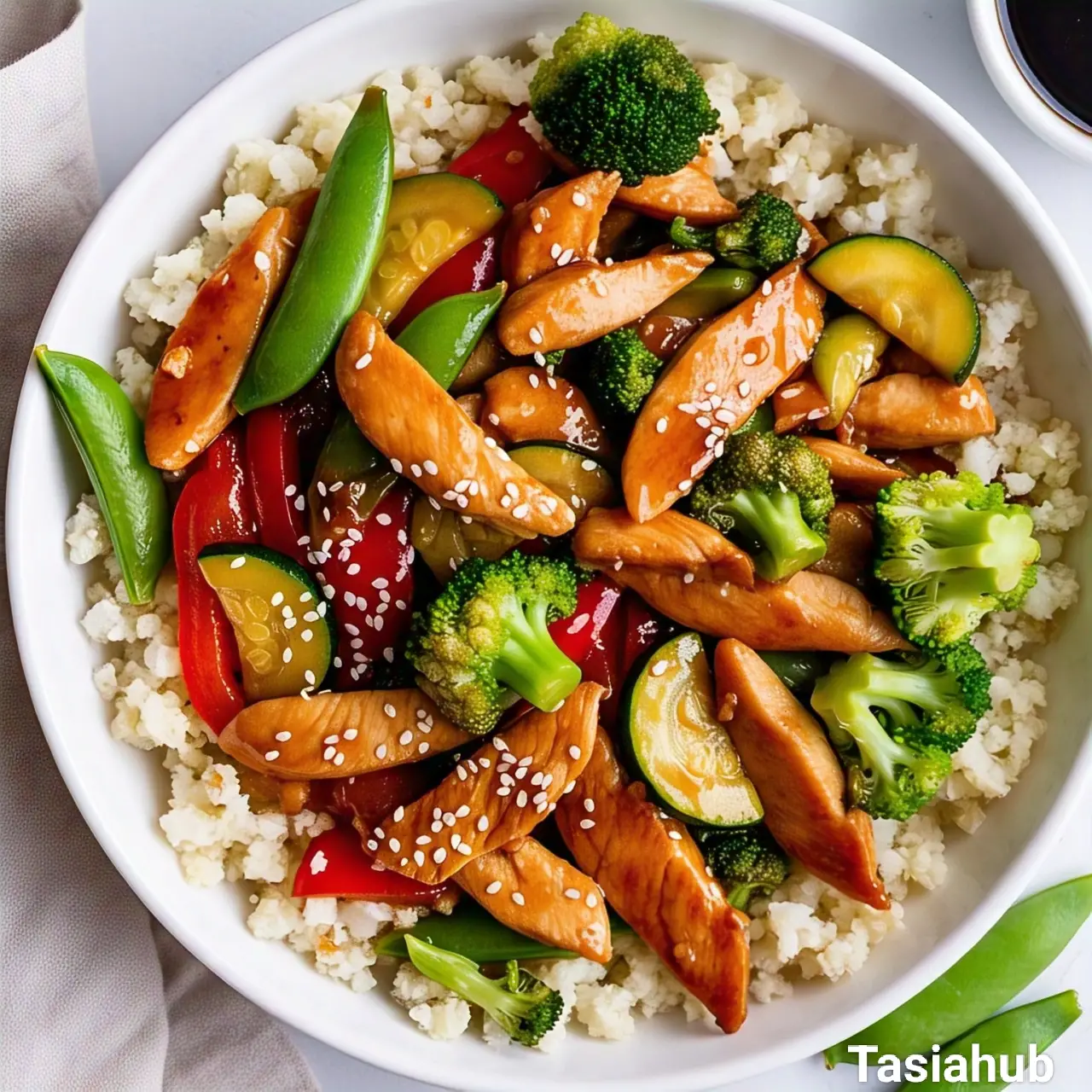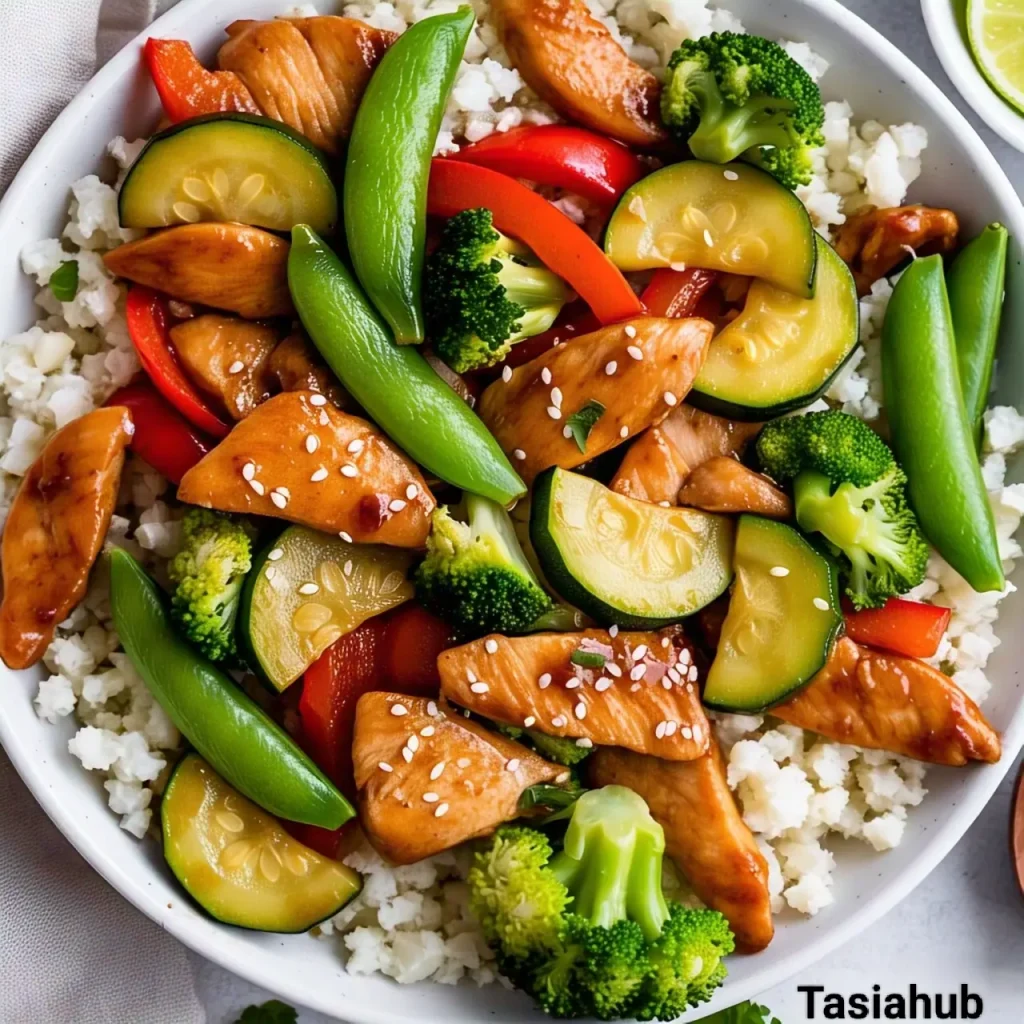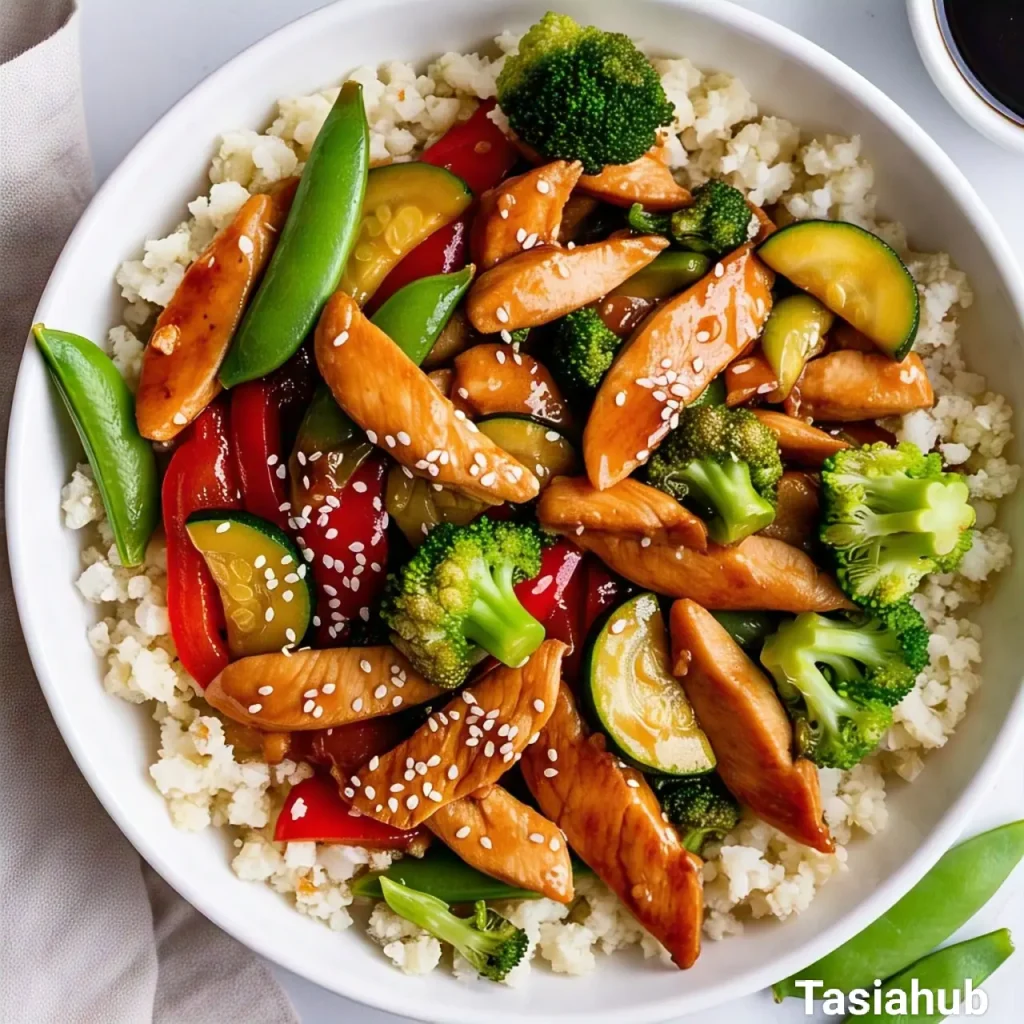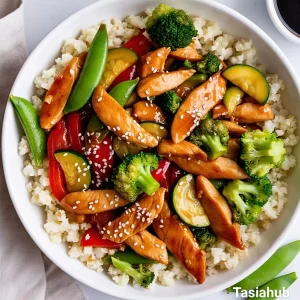Keto Chicken Stir Fry

If you’re anything like me, you love a good stir fry! The combination of veggies, meat, and savory sauces is always a win in my book. But when I started my keto journey, I realized that some stir-fry recipes just didn’t fit with the low-carb lifestyle.
So, I decided to create a keto-friendly stir fry that still packs all the flavor and satisfaction of a traditional stir fry but without the carbs.
I love how customizable this keto stir-fry is. You can switch up the veggies, choose your favorite protein, and even play with different spices to make it your own. Plus, it comes together so quickly, making it perfect for those busy days when you want a tasty meal without spending hours in the kitchen.
Whether you’re new to keto or a seasoned pro, this stir fry will become one of your go-to recipes.
What is Keto Stir Fry?
Keto stir-fry is a low-carb, high-fat version of the classic stir-fry dish. It typically includes fresh vegetables, a protein source like chicken, beef, shrimp, or tofu, and a flavorful sauce — all while keeping carbs to a minimum.
By using keto-friendly ingredients, such as cauliflower rice instead of regular rice and avoiding sugary sauces, this stir fry keeps your meals in line with the ketogenic diet.
Why You’ll Love It
- Quick and Easy: This dish can be made in under 30 minutes, making it perfect for busy weeknights.
- Customizable: Whether you prefer chicken, beef, shrimp, or even tofu, you can easily switch up the protein and veggies to match your tastes.
- Low-Carb and Keto-Friendly: No need to worry about hidden carbs — this recipe keeps things low-carb, so it fits perfectly into a keto lifestyle.
- Packed with Flavor: With a savory sauce, a mix of fresh veggies, and the option to spice things up, this stir fry is bursting with flavor.
- One-Pan Meal: Less mess and more time enjoying your meal! Everything comes together in one pan, making cleanup a breeze.
Ingredient List
For the Stir Fry:
- 1 lb chicken breast, thinly sliced (or your choice of protein)
- 2 tbsp olive oil (or coconut oil)
- 1 bell pepper, sliced
- 1 medium zucchini, sliced
- 1 cup broccoli florets
- 1/2 cup snap peas
- 2 cloves garlic, minced
- 1-inch piece of fresh ginger, grated
For the Sauce:
- 3 tbsp soy sauce or tamari (for gluten-free option)
- 1 tbsp sesame oil
- 1 tbsp rice vinegar
- 1 tbsp Swerve or preferred keto-friendly sweetener
- 1 tsp chili paste or sriracha (optional for heat)
- 1 tsp sesame seeds (for garnish, optional)
For the Rice:
- 2 cups cauliflower rice (fresh or frozen)
Ingredient Notes
- I always use tamari for a gluten-free option — it gives the sauce a rich umami flavor.
- Don’t skip the fresh ginger! It adds a burst of freshness and depth to the sauce.
- Cauliflower rice is a great low-carb alternative to regular rice. You can find it frozen, which makes it super convenient!
- I recommend using sesame oil in the sauce — it gives the stir fry a nutty, toasted flavor that’s essential for the perfect dish.
Kitchen Tools Needed
- Wok or Large Skillet: Essential for stir-frying the vegetables and protein quickly and evenly.
- Sharp Knife: For slicing the chicken and veggies. A good Santoku knife is perfect for quick, precise cuts.
- Grater: For grating fresh ginger.
- Spatula or Tongs: To toss everything around in the pan without sticking or burning. I always use a silicone spatula to avoid damaging my cookware.
- Measuring Spoons: For getting the sauce ingredients right.
- Cutting Board: For prepping your veggies and protein. A large bamboo cutting board is my go-to — it’s durable and easy to wipe clean.
Instructions
Step 1: Prepare Your Ingredients
- Slice the chicken: Take the chicken breast and slice it thinly against the grain. This helps the chicken cook evenly and stay tender.
- Chop the vegetables: Slice the bell pepper, zucchini, and broccoli into bite-sized pieces. This ensures everything cooks quickly and uniformly.
- Mince the garlic and grate the ginger: Set them aside so they’re ready to add to the pan. Fresh garlic and ginger make all the difference in the flavor!
Step 2: Make the Sauce
- Combine the sauce ingredients: In a small bowl, whisk together the soy sauce (or tamari), sesame oil, rice vinegar, sweetener (like Swerve), and chili paste or sriracha (if using). Stir until the sweetener dissolves and everything is well combined.
- Taste test: Adjust the seasoning to your liking. If you like it sweeter, add a bit more sweetener; if you like it spicier, add more chili paste.
Pro Tip: Taste your sauce before adding it to the stir fry — it’s easier to adjust at this stage than after it’s cooked.
Step 3: Cook the Cauliflower Rice
- Heat the pan: In a separate pan, heat 1 tablespoon of olive oil over medium heat.
- Cook the cauliflower rice: Add the cauliflower rice to the pan and cook for 5–7 minutes, stirring occasionally. If using frozen cauliflower rice, let it cook until the excess moisture evaporates, and it’s tender but not mushy.
- Season it: Add a pinch of salt and pepper for flavor. Set aside once done.
Step 4: Stir-fry the Chicken
- Heat your wok or skillet: Add 1 tablespoon of olive oil to the pan and heat it over medium-high heat.
- Cook the chicken: Once the oil is hot, add the sliced chicken and cook for about 5–6 minutes, stirring occasionally, until it’s browned and cooked through. Remove the chicken from the pan and set it aside.
Pro Tip: Don’t overcrowd the pan! If you’re making a large batch, cook the chicken in batches to ensure it browns nicely instead of steaming.
Step 5: Stir-Fry the Veggies
- Sauté the garlic and ginger: In the same pan, add a little more oil if needed. Toss in the minced garlic and grated ginger. Stir constantly for 30 seconds to prevent burning and to release their fragrant oils.
- Cook the veggies: Add the sliced bell pepper, zucchini, broccoli, and snap peas. Stir-fry the veggies for about 5 minutes or until they’re tender-crisp, keeping them moving in the pan to prevent burning.
Pro Tip: Keep the veggies moving! Stir-frying works best when everything stays in motion, ensuring even cooking.
Step 6: Combine and Add the Sauce
- Add the chicken back in: Once the veggies are tender, add the cooked chicken back into the pan.
- Pour in the sauce: Drizzle the sauce over the chicken and vegetables. Stir everything together, making sure the sauce coats everything evenly.
- Let it simmer: Let everything cook together for an additional 2-3 minutes to allow the flavors to meld. You want the sauce to thicken slightly and coat the ingredients well.
Step 7: Serve and Enjoy!
- Plate the stir fry: Spoon the stir fry over the cauliflower rice you cooked earlier. Garnish with sesame seeds if desired for a little crunch and extra flavor.
- Enjoy your meal: Serve hot and enjoy the bold, savory flavors of your keto stir fry!
Pro Tip: If you like a little extra heat, add a drizzle of extra chili paste or sriracha on top right before serving for a kick!

Tips and Tricks for Success
- Prep Ahead: To save time, you can slice your vegetables and protein ahead of time and store them in the fridge. This makes assembly much quicker when you’re ready to cook.
- Don’t Skip the Ginger: Fresh ginger adds a unique, aromatic flavor that enhances the dish. If you don’t have fresh ginger, you can use ground ginger in a pinch, but fresh is always best!
- Use a High Heat: Stir-frying works best with high heat, so make sure your pan is nice and hot before adding the oil and ingredients. This helps to sear the chicken and veggies, locking in flavor and keeping the texture crisp.
- Be Flexible with Vegetables: This recipe is super versatile. If you don’t like broccoli or snap peas, feel free to swap them out for your favorite veggies, like mushrooms, spinach, or green beans.
- Double the Sauce: If you love extra sauce for your stir fry, feel free to double the sauce ingredients. Just be sure to adjust the seasoning as you go.
- Keep it Crispy: To prevent soggy veggies, don’t overcrowd the pan. Give the ingredients enough room to cook evenly and retain their crispness.
Ingredient Substitutions and Variations
- Protein Swap: Instead of chicken, try using beef, shrimp, tofu, or even pork. Each will bring a different texture and flavor to the stir-fry.
- Soy Sauce Alternatives: If you need a gluten-free option, use tamari or coconut aminos as a substitute for regular soy sauce.
- Sweetener Options: If you don’t have Swerve, you can use stevia, monk fruit sweetener, or erythritol as an alternative to keep the dish keto-friendly.
- Veggie Substitutes: Swap the cauliflower rice for zucchini noodles (zoodles) for a fresh take on the dish, or try shirataki rice if you’re looking for another low-carb option.
- Spice Variations: If you like things spicy, increase the amount of chili paste or add fresh chopped chilies for an extra kick. For a milder version, skip the chili paste and use a dash of paprika or cayenne instead.
- Add Nuts: For extra crunch, toss in some chopped almonds or cashews just before serving. They add a great texture contrast to the stir-fry.
Serving Suggestions
- Serve with Cauliflower Rice: This is my go-to base. It’s low-carb, so it pairs perfectly with this keto stir fry while giving you that “rice” feel without the carbs.
- Pair with a Fresh Salad: A light, crisp salad with a tangy vinaigrette balances out the rich flavors of this stir-fry. I like a simple cucumber and avocado salad with olive oil and lemon juice.
- Add a Side of Steamed Veggies: For more veggies, serve the stir fry with a side of steamed asparagus or green beans.
- Top with a Fried Egg: For an extra indulgent twist, top your stir fry with a fried egg.
- Serve with Keto Noodles: If you miss noodles, try serving your stir fry with keto-friendly noodles made from zucchini or shirataki noodles.

Storage and Reheating Instructions
- Storage: Store leftover stir fry in an airtight container in the fridge for up to 3 days. The cauliflower rice will keep its texture, but the veggies may soften a bit.
- Reheating: Reheat in a skillet over medium heat, adding a splash of water or broth to keep the stir-fry moist. Stir occasionally to ensure even heating.
- Freezing: You can freeze the stir fry for up to 1 month. When freezing, it’s best to separate the chicken, veggies, and rice in different containers to prevent sogginess. Thaw in the fridge overnight before reheating.
- Reheat in the Microwave: For a quick meal, you can reheat the stir fry in the microwave for 2-3 minutes. Stir halfway through to ensure it heats evenly.
Frequently Asked Questions
Can I make this stir-fry vegetarian?
Absolutely! You can easily swap the chicken for tofu or tempeh for a vegetarian version. Just make sure to press the tofu to remove excess water so it crisps up nicely in the pan.
Can I use frozen vegetables for this stir-fry?
Yes, you can! If you’re using frozen vegetables, just make sure to thaw and drain them before cooking. You may need to cook them for a little less time to prevent them from becoming too soft.
How do I make this stir-fry spicier?
To kick up the heat, add more chili paste or sriracha to the sauce. You can also toss in some fresh chili peppers or red pepper flakes while cooking the veggies for extra spice.
Is this recipe gluten-free?
Yes! If you use tamari instead of soy sauce, this stir-fry will be fully gluten-free. Just make sure all your other ingredients are certified gluten-free as well.
Can I use a different kind of rice instead of cauliflower rice?
For a non-keto version, you can use regular white rice, brown rice, or even quinoa. But for keeping it low-carb, cauliflower rice is your best bet!
How can I make this stir-fry ahead of time?
You can prep the ingredients ahead of time — slice the chicken and vegetables and store them in the fridge. You can also make the sauce and store it in an airtight container. When you’re ready to cook, everything will be ready to go!
I’d love to hear your thoughts on this keto stir fry! Drop a comment below or connect with me on social media for more easy and delicious recipes.

Keto Chicken Stir Fry
Equipment
- Wok or Large Skillet
- Sharp Knife
- Grater
- Spatula or tongs
- Measuring spoons
- Cutting board
Ingredients
For the Stir Fry:
- 1 lb chicken breast thinly sliced (or your choice of protein)
- 2 tbsp olive oil or coconut oil
- 1 bell pepper sliced
- 1 medium zucchini sliced
- 1 cup broccoli florets
- 1/2 cup snap peas
- 2 cloves garlic minced
- 1- inch piece of fresh ginger grated
For the Sauce:
- 3 tbsp soy sauce or tamari for gluten-free option
- 1 tbsp sesame oil
- 1 tbsp rice vinegar
- 1 tbsp Swerve or preferred keto-friendly sweetener
- 1 tsp chili paste or sriracha optional for heat
- 1 tsp sesame seeds for garnish, optional
For the Rice:
- 2 cups cauliflower rice fresh or frozen
Instructions
Step 1: Prepare Your Ingredients
- Slice the chicken: Take the chicken breast and slice it thinly against the grain. This helps the chicken cook evenly and stay tender.
- Chop the vegetables: Slice the bell pepper, zucchini, and broccoli into bite-sized pieces. This ensures everything cooks quickly and uniformly.
- Mince the garlic and grate the ginger: Set them aside so they’re ready to add to the pan. Fresh garlic and ginger make all the difference in the flavor!
Step 2: Make the Sauce
- Combine the sauce ingredients: In a small bowl, whisk together the soy sauce (or tamari), sesame oil, rice vinegar, sweetener (like Swerve), and chili paste or sriracha (if using). Stir until the sweetener dissolves and everything is well combined.
- Taste test: Adjust the seasoning to your liking. If you like it sweeter, add a bit more sweetener; if you like it spicier, add more chili paste.
- Pro Tip: Taste your sauce before adding it to the stir fry — it’s easier to adjust at this stage than after it’s cooked.
Step 3: Cook the Cauliflower Rice
- Heat the pan: In a separate pan, heat 1 tablespoon of olive oil over medium heat.
- Cook the cauliflower rice: Add the cauliflower rice to the pan and cook for 5–7 minutes, stirring occasionally. If using frozen cauliflower rice, let it cook until the excess moisture evaporates, and it’s tender but not mushy.
- Season it: Add a pinch of salt and pepper for flavor. Set aside once done.
Step 4: Stir Fry the Chicken
- Heat your wok or skillet: Add 1 tablespoon of olive oil to the pan and heat it over medium-high heat.
- Cook the chicken: Once the oil is hot, add the sliced chicken and cook for about 5–6 minutes, stirring occasionally, until it’s browned and cooked through. Remove the chicken from the pan and set it aside.
- Pro Tip: Don’t overcrowd the pan! If you’re making a large batch, cook the chicken in batches to ensure it browns nicely instead of steaming.
Step 5: Stir Fry the Veggies
- Sauté the garlic and ginger: In the same pan, add a little more oil if needed. Toss in the minced garlic and grated ginger. Stir constantly for 30 seconds to prevent burning and to release their fragrant oils.
- Cook the veggies: Add the sliced bell pepper, zucchini, broccoli, and snap peas. Stir-fry the veggies for about 5 minutes or until they’re tender-crisp, keeping them moving in the pan to prevent burning.
- Pro Tip: Keep the veggies moving! Stir-frying works best when everything stays in motion, ensuring even cooking.
Step 6: Combine and Add the Sauce
- Add the chicken back in: Once the veggies are tender, add the cooked chicken back into the pan.
- Pour in the sauce: Drizzle the sauce over the chicken and vegetables. Stir everything together, making sure the sauce coats everything evenly.
- Let it simmer: Let everything cook together for an additional 2-3 minutes to allow the flavors to meld. You want the sauce to thicken slightly and coat the ingredients well.
Step 7: Serve and Enjoy!
- Plate the stir fry: Spoon the stir fry over the cauliflower rice you cooked earlier. Garnish with sesame seeds if desired for a little crunch and extra flavor.
- Enjoy your meal: Serve hot and enjoy the bold, savory flavors of your keto stir fry!
- Pro Tip: If you like a little extra heat, add a drizzle of extra chili paste or sriracha on top right before serving for a kick!
Notes
Nutritional Value (per serving)
- Calories: 320–350 kcal
- Protein: 28–30g
- Fat: 18–20g
- Carbohydrates: 8–10g
- Fiber: 3–4g
- Net Carbs: 5–7g
The nutritional information provided on this website is an estimate only and is intended for general guidance. We cannot guarantee its accuracy and recommend consulting a qualified healthcare professional or registered dietitian for personalized nutrition advice.